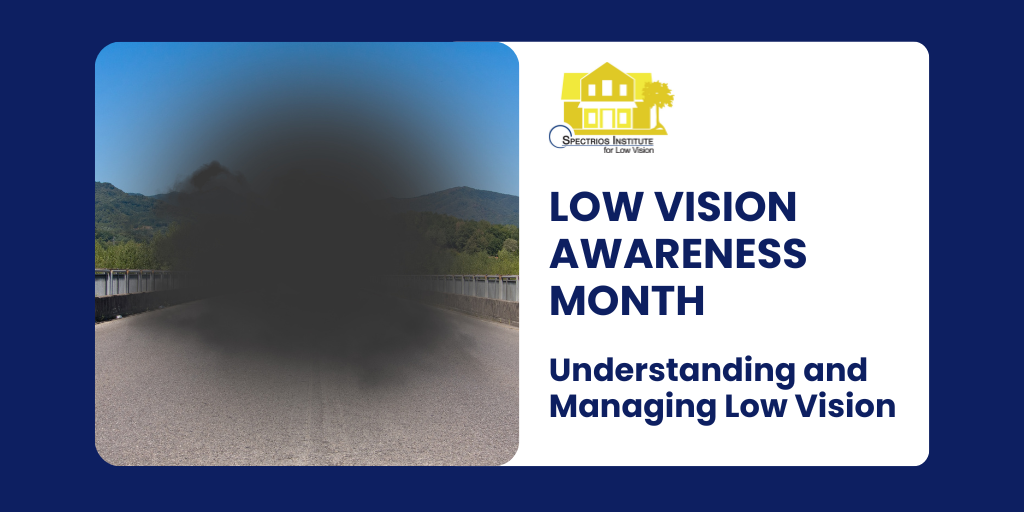
February is Low Vision Awareness Month:
Understanding and Managing Low Vision
February is Low Vision Awareness Month—an important time to raise awareness and educate others about this prevalent eye condition that’s often misunderstood. In the United States alone, 12 million people aged 40 and over experience some form of vision impairment. Nearly 3 million individuals live with low vision. The National Eye Institute (NEI) projects that number to increase to 5 million by 2030. Given this significant increase, it’s critical to understand what low vision is, its effects, and the how early detection and management can play a critical role in maintaining quality of life.
What Is Low Vision?
Low vision is a significant visual impairment that cannot be corrected with standard glasses, contact lenses, medication, or surgery. Activities that once seemed simple—like reading the mail, cooking, or driving—can become increasingly challenging.
Unlike complete blindness, individuals with low vision retain some sight, though it may be blurry, distorted, or restricted in the field of view. This can greatly affect a person’s independence, self-esteem, and overall quality of life. However, with proper management and support, individuals can adapt and maintain their independence.
The Importance of Early Detection
Regular eye exams are vital because early detection is key to preventing serious eye diseases. Many conditions that cause low vision develop gradually, often without noticeable symptoms. Through regular check-ups, your eye doctor can track your ocular health and identify potential issues before they worsen.
If you or a loved one experience any of the following symptoms, it’s essential to consult with an eye care professional:
Loss of Central Vision — This creates a blur or blind spot in the center of your visual field, while side (peripheral) vision remains intact. It may become challenging to read, recognize faces, or see distant details. Despite these difficulties, mobility is usually unaffected due to preserved peripheral vision.
Loss of Peripheral (Side) Vision — Also known as “tunnel vision,” this involves an inability to see objects to the sides, above, or below your direct line of sight. Central vision remains, allowing you to see straight ahead. Peripheral vision loss can impact mobility and slow reading speed, as fewer words are visible at once.
Blurred Vision — Blurred vision affects both near and far sight, making everything appear out of focus even with the best corrective lenses.
Generalized Haze — This symptom feels like a film or glare covering your entire field of view, reducing clarity and comfort.
Extreme Light Sensitivity — Standard levels of illumination may overwhelm the visual system, causing washed-out images, glare, or even pain and discomfort.
Night Blindness — This is the inability to see in low-light settings, such as outdoors at night, dimly lit restaurants, or movie theaters.
Recognizing these symptoms early allows you to take proactive steps in managing your eye health with a low vision specialist. Timely intervention is essential to minimize the impact of low vision on your daily life and maintain your independence.
Common Causes of Low Vision
Low vision can result from a variety of eye diseases and health conditions. People can also be born with conditions such as albinism or optic nerve damage that can lead to low vision. Here are some of the most common causes:
Age-Related Macular Degeneration (AMD) — Age-related macular degeneration (AMD) is an eye disease that can blur or distort your central vision. It happens when aging causes damage to the macula—the part of the eye that controls sharp, straight-ahead vision. AMD is a leading cause of vision loss in people over 50.
Glaucoma — Glaucoma most commonly occurs when the eye pressure is too high. It can cause a gradual loss of peripheral vision and, if untreated, may lead to total blindness.
Diabetic Retinopathy — Diabetic retinopathy occurs as a complication of diabetes. High blood sugar levels damage the tiny blood vessels in the retina and may cause blurred vision and floaters. Significant vision loss may occur if left untreated.
Cataracts — Cataracts develop when the eye’s natural lens becomes cloudy or opaque. Often associated with aging, cataracts generally form slowly and without pain. They can affect one or both eyes. Over time, a cataract may interfere with vision, causing blurry vision, glare, and difficulty seeing in low light.
Low Vision Management Techniques
Managing low vision requires a comprehensive approach, integrating medical interventions, vision rehabilitation, assistive tools, and lifestyle adjustments.
Vision rehabilitation focuses on teaching individuals how to adapt to their vision loss and use their remaining vision effectively. This includes:
Personalized Treatment Plans — A comprehensive evaluation conducted by a low vision-trained eye doctor, who prescribes devices and tailors a program to help you achieve your unique goals.
Occupational Therapy (OT) — Helps individuals develop daily living skills, such as cooking, grooming, and navigating their environment.
Access Technology & Assistive Tools — Provides training on devices such as screen readers, magnification tools, smartphone apps, handheld magnifiers, and text-to-speech software, helping individuals with low vision enhance their remaining sight and daily living.
Community Engagement
Vision affects every aspect of life, and the connection between mental health and vision impairment must not be overlooked. A supportive community can help individuals with low vision navigate the overwhelm, frustration, and sadness that often accompany vision loss. Connecting with others who share similar experiences fosters emotional resilience and offers valuable coping strategies.
Enhancing Vision, Empowering Independence, and Offering Hope
At Spectrios Institute for Low Vision, we’re dedicated to maximizing visual capabilities and independence through prescriptive tools, technology, rehabilitative training, and inspiration. We provide functional vision exams, personalized rehabilitation plans, occupational therapy, and adaptive technology training and support for both children and adults with low vision. Our “head, heart, and eye” approach addresses the whole person offering hope grounded in science. From rehabilitation and occupational therapy to access technology training and community resources, we empower individuals with the tools and guidance needed to thrive despite vision challenges.
If you or a loved one are noticing signs of low vision or have concerns about eye health, we encourage you to reach out. Schedule an eye exam with Spectrios, or consult your eye care provider about referrals. Together, we can explore the best strategies to manage your unique low vision needs.
Article by:
Dr. Rachel Park, OD, FAAO
Dr. Park is the Clinical Director at Spectrios Institute in Wheaton, IL. A graduate of the Illinois College of Optometry, she specializes in low vision care and is passionate about enhancing patient independence.
